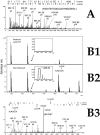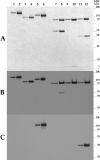Recombinant derivatives of botulinum neurotoxin A engineered for trafficking studies and neuronal delivery
- PMID: 20045734
- PMCID: PMC2830362
- DOI: 10.1016/j.pep.2009.12.013
Recombinant derivatives of botulinum neurotoxin A engineered for trafficking studies and neuronal delivery
Abstract
Work from multiple laboratories has clarified how the structural domains of botulinum neurotoxin A (BoNT/A) disable neuronal exocytosis, but important questions remain unanswered. Because BoNT/A intoxication disables its own uptake, light chain (LC) does not accumulate in neurons at detectable levels. We have therefore designed, expressed and purified a series of BoNT/A atoxic derivatives (ad) that retain the wild type features required for native trafficking. BoNT/A1ad(ek) and BoNT/A1ad(tev) are full length derivatives rendered atoxic through double point mutations in the LC protease (E(224)>A; Y(366)>A). DeltaLC-peptide-BoNT/A(tev) and DeltaLC-GFP-BoNT/A(tev) are derivatives wherein the catalytic portion of the LC is replaced with a short peptide or with GFP plus the peptide. In all four derivatives, we have fused the S6 peptide sequence GDSLSWLLRLLN to the N-terminus of the proteins to enable site-specific attachment of cargo using Sfp phosphopantetheinyl transferase. Cargo can be attached in a manner that provides a homogeneous derivative population rather than a polydisperse mixture of singly and multiply-labeled molecular species. All four derivatives contain an introduced cleavage site for conversion into disulfide-bonded heterodimers. These constructs were expressed in a baculovirus system and the proteins were secreted into culture medium and purified to homogeneity in yields ranging from 1 to 30 mg per liter. These derivatives provide unique tools to study toxin trafficking in vivo, and to assess how the structure of cargo linked to the heavy chain (HC) influences delivery to the neuronal cytosol. Moreover, they create the potential to engineer BoNT-based molecular vehicles that can target therapeutic agents to the neuronal cytoplasm.
Copyright (c) 2009 Elsevier Inc. All rights reserved.
Figures






References
-
- National Institute of Occupational Safety and Health . Registry of Toxic Effects of Chemical Substances (R-TECS) National Institute of Occupational Safety and Health; Cincinnati, Ohio: 1996.
-
- Simpson LL. Identification of the major steps in botulinum toxin action. Annu. Rev. Pharmacol. Toxicol. 2004;44:167–193. - PubMed
-
- Koriazova LK, Montal M. Translocation of botulinum neurotoxin light chain protease through the heavy chain channel. Nat. Struct. Biol. 2003;10(1):13–18. - PubMed
-
- Dekleva ML, DasGupta BR, Sathyamoorthy V. Botulinum neurotoxin type A radiolabeled at either the light or the heavy chain. Arch. Biochem. Biophys. 1989;274(1):235–240. - PubMed
Publication types
MeSH terms
Substances
Grants and funding
LinkOut - more resources
Full Text Sources
Other Literature Sources
Medical
Research Materials

